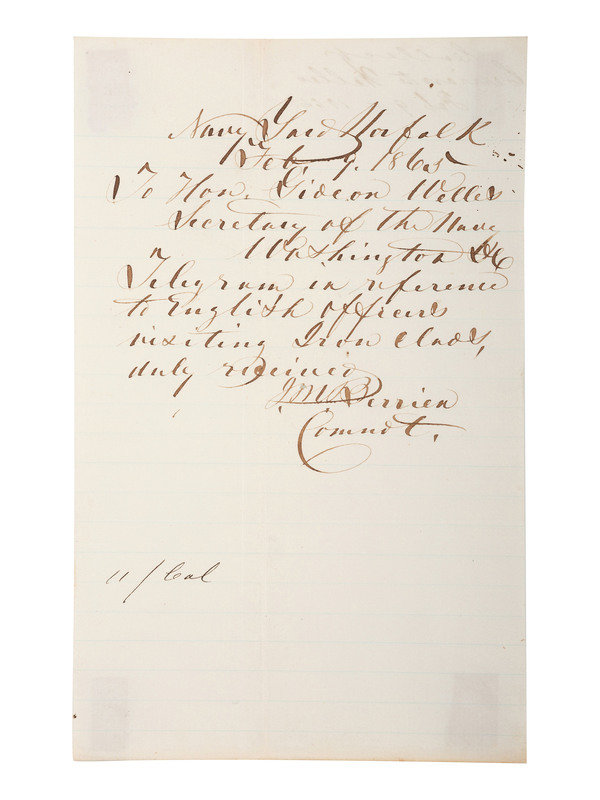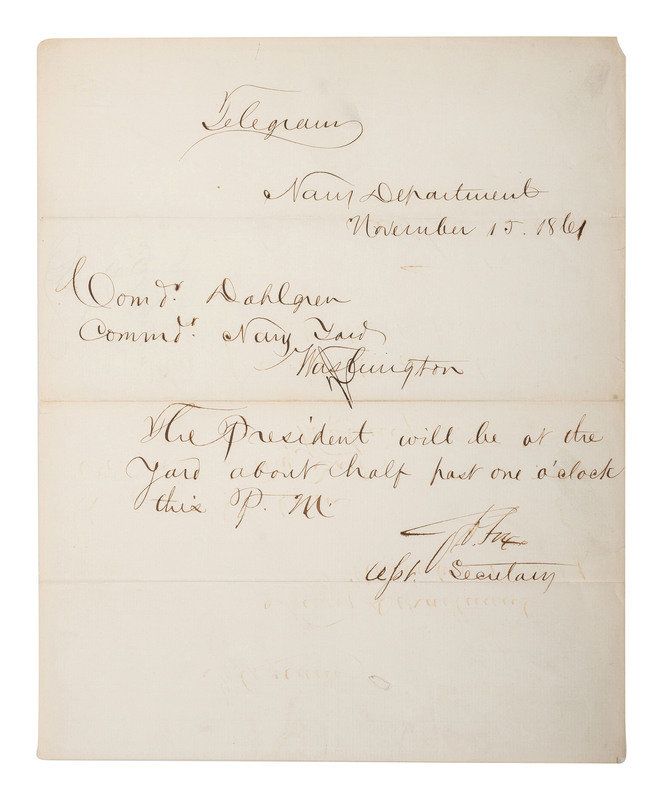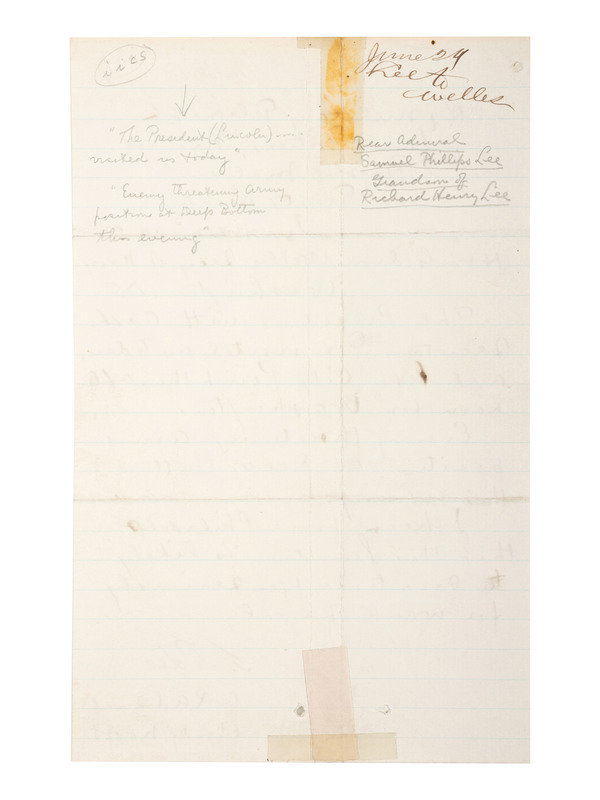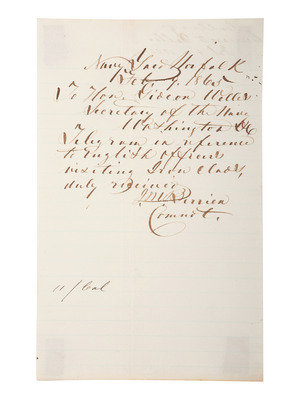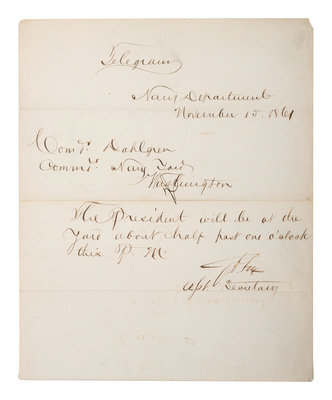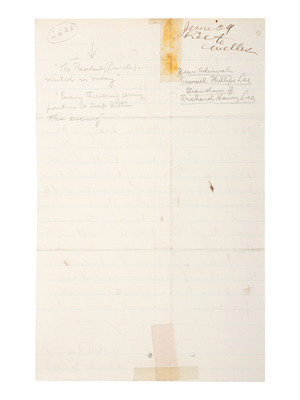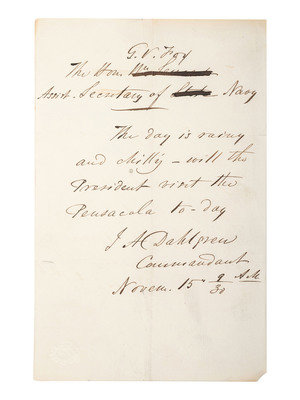Lot 529
[CIVIL WAR - NAVY] -- [LINCOLNIANA]. A group of 6 documents relating to Lincoln naval visits, comprising:
Sale 960 - American Historical Ephemera & Photography
Nov 15, 2021
11:00AM ET
Live / Cincinnati
Own a similar item?
Estimate
$500 -
1,000
Price Realized
$12,500
Sold prices are inclusive of Buyer’s Premium
Lot Description
[CIVIL WAR - NAVY] -- [LINCOLNIANA]. A group of 6 documents relating to Lincoln naval visits, comprising:
FOX, Gustavus Vasa, Asst. Sec. Ds, 1 p., 4to, 22 March 1865, text of a telegraph to J. B. Montgomery, Comm. Washington Navy Yard: “Have the Bat ready to convoy the ‘River Queen’ to morrow noon. The President will be in the ‘River Queen’ bound to City Point.” Fairly early in the War, President Lincoln had developed the habit of visiting the Navy Yard and boarding a boat in order to learn about armaments from Dahlgren, and to escape the pressures of the job. Dahlgren had long since moved on, and this might have been Lincoln’s last visit to the Yard. He was shot at Ford’s Theater just over three weeks later.
[With:] FOX, Gustavus Vasa, Asst. Sec. Ds, 1 p., 4to, text of a telegram, 23 March 1865, to J. B. Montgomery: “The ‘River Queen’ leaves the 6th Street wharf about 1 p.m. with the President. Have the ‘Bat’ accompany her to City Point and back.”
[With:] BERRIEN, J. M.[?], Commt. Norfolk Navy Yard. ALs, I p., 8vo, 9 February 1865, to Gideon WELLES, acknowledging Welles’s telegram about British officers visiting ironclads being received.
[With:] DAHLGREN, John A. ALs, I p., 16mo, 15 November n.y. [1861], 9:30 am, to G. V. FOX: “The day is rainy and chilly—will the President visit the Pensacola today[?]” Signed “J.A. Dahlgren / Commandant.” President Lincoln did, in fact, visit the Pensacola Navy Yard in November 1861.
[With:] BERRIEN, J. M.[?], Commt. Norfolk Navy Yard. ALs, I p., 8vo, 9 February 1865, to Gideon WELLES, acknowledging Welles’s telegram about British officers visiting ironclads being received.
[With:] DAHLGREN, John A. ALs, I p., 16mo, 15 November n.y. [1861], 9:30 am, to G. V. FOX: “The day is rainy and chilly—will the President visit the Pensacola today[?]” Signed “J.A. Dahlgren / Commandant.” President Lincoln did, in fact, visit the Pensacola Navy Yard in November 1861.
[With:] FOX, Gustavus Vasa, Asst. Sec. Navy. Ds, 1 p., 4to, text of a telegram, 15 November 1861, to J. A. DAHLGREN, Comm. Washington Navy Yard: “The President will be at the Yard about half past one o’clock this P. M.” Signed "G.V. Fox."
[With:] LEE, S.[amuel] P.[hillips], Acting Rear Admiral. Ds, 22 June n.y. [1864?], text of a telegram from Fortress Monroe onboard the Flagship Malvern, to Gideon Welles: The President with Asst. Secretary Fox visited us to day, and left City Point this afternoon for Washington. ¶ Enemy threating Army position at Deep Bottom this evening. ¶ I hear from Philadelphia that the Squadron is likely soon to suffer seriously for want of coal.” Signed “S. P. Lee / A.R.A. / Comdg N.[orth A.[tlantic] B.[lockading] S.[quadron].” Lee was Welles’ surprise pick to command the N.A.B.S. At its height, Lee commanded over one hundred ships which patrolled the thousands of miles of coast, rivers, sounds, and inlets on the Atlantic Coast between southeastern Virginia and the southern boundary of North Carolina. Lee's knowledge of the coast, from his early days with the Coast Survey, along with his good business qualities and untiring appetite for precise and detailed work, made his blockade effective and profitable.
[With:] LEE, S.[amuel] P.[hillips], Acting Rear Admiral. Ds, 22 June n.y. [1864?], text of a telegram from Fortress Monroe onboard the Flagship Malvern, to Gideon Welles: The President with Asst. Secretary Fox visited us to day, and left City Point this afternoon for Washington. ¶ Enemy threating Army position at Deep Bottom this evening. ¶ I hear from Philadelphia that the Squadron is likely soon to suffer seriously for want of coal.” Signed “S. P. Lee / A.R.A. / Comdg N.[orth A.[tlantic] B.[lockading] S.[quadron].” Lee was Welles’ surprise pick to command the N.A.B.S. At its height, Lee commanded over one hundred ships which patrolled the thousands of miles of coast, rivers, sounds, and inlets on the Atlantic Coast between southeastern Virginia and the southern boundary of North Carolina. Lee's knowledge of the coast, from his early days with the Coast Survey, along with his good business qualities and untiring appetite for precise and detailed work, made his blockade effective and profitable.
The Richard B. Cohen Civil War Collection
Condition Report
Contact Information
Auction Specialist


